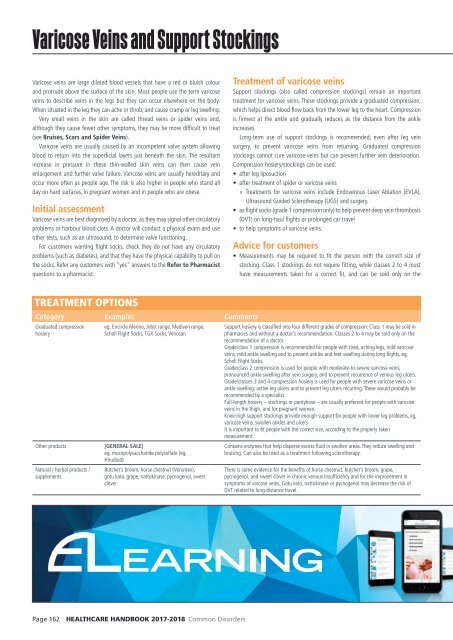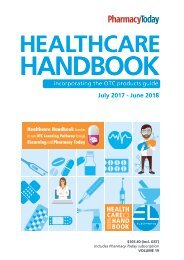2017 HCHB_digital
Create successful ePaper yourself
Turn your PDF publications into a flip-book with our unique Google optimized e-Paper software.
Varicose Veins and Support Stockings<br />
Varicose veins are large dilated blood vessels that have a red or bluish colour<br />
and protrude above the surface of the skin. Most people use the term varicose<br />
veins to describe veins in the legs but they can occur elsewhere on the body.<br />
When situated in the leg they can ache or throb, and cause cramp or leg swelling.<br />
Very small veins in the skin are called thread veins or spider veins and,<br />
although they cause fewer other symptoms, they may be more difficult to treat<br />
(see Bruises, Scars and Spider Veins).<br />
Varicose veins are usually caused by an incompetent valve system allowing<br />
blood to return into the superficial layers just beneath the skin. The resultant<br />
increase in pressure in these thin-walled skin veins can then cause vein<br />
enlargement and further valve failure. Varicose veins are usually hereditary and<br />
occur more often as people age. The risk is also higher in people who stand all<br />
day on hard surfaces, in pregnant women and in people who are obese.<br />
Initial assessment<br />
Varicose veins are best diagnosed by a doctor, as they may signal other circulatory<br />
problems or harbour blood clots. A doctor will conduct a physical exam and use<br />
other tests, such as an ultrasound, to determine valve functioning.<br />
For customers wanting flight socks, check they do not have any circulatory<br />
problems (such as diabetes), and that they have the physical capability to pull on<br />
the socks. Refer any customers with "yes" answers to the Refer to Pharmacist<br />
questions to a pharmacist.<br />
Treatment of varicose veins<br />
Support stockings (also called compression stockings) remain an important<br />
treatment for varicose veins. These stockings provide a graduated compression,<br />
which helps direct blood flow back from the lower leg to the heart. Compression<br />
is firmest at the ankle and gradually reduces as the distance from the ankle<br />
increases.<br />
Long-term use of support stockings is recommended, even after leg vein<br />
surgery, to prevent varicose veins from returning. Graduated compression<br />
stockings cannot cure varicose veins but can prevent further vein deterioration.<br />
Compression hosiery/stockings can be used:<br />
• after leg liposuction<br />
• after treatment of spider or varicose veins<br />
»»<br />
Treatments for varicose veins include Endovenous Laser Ablation (EVLA),<br />
Ultrasound Guided Sclerotherapy (UGS) and surgery.<br />
• as flight socks (grade 1 compression only) to help prevent deep vein thrombosis<br />
(DVT) on long-haul flights or prolonged car travel<br />
• to help symptoms of varicose veins.<br />
Advice for customers<br />
• Measurements may be required to fit the person with the correct size of<br />
stocking. Class 1 stockings do not require fitting, while classes 2 to 4 must<br />
have measurements taken for a correct fit, and can be sold only on the<br />
TREATMENT OPTIONS<br />
Category Examples Comments<br />
Graduated compression<br />
hosiery<br />
Other products<br />
Natural / herbal products /<br />
supplements<br />
eg, Encircle Merino, Jobst range, Mediven range,<br />
Scholl Flight Socks, TGX Socks, Venosan<br />
[GENERAL SALE]<br />
eg, mucopolysaccharide polysulfate (eg,<br />
Hirudoid)<br />
Butcher’s broom, horse chestnut (Venotrex),<br />
gotu kola, grape, nattokinase, pycnogenol, sweet<br />
clover<br />
Support hosiery is classified into four different grades of compression: Class 1 may be sold in<br />
pharmacies and without a doctor’s recommendation. Classes 2 to 4 may be sold only on the<br />
recommendation of a doctor.<br />
Grade/class 1 compression is recommended for people with tired, aching legs, mild varicose<br />
veins, mild ankle swelling and to prevent ankles and feet swelling during long flights, eg,<br />
Scholl Flight Socks.<br />
Grade/class 2 compression is used for people with moderate-to-severe varicose veins,<br />
pronounced ankle swelling after vein surgery, and to prevent recurrence of venous leg ulcers.<br />
Grade/classes 3 and 4 compression hosiery is used for people with severe varicose veins or<br />
ankle swelling, active leg ulcers and to prevent leg ulcers recurring. These would probably be<br />
recommended by a specialist.<br />
Full-length hosiery – stockings or pantyhose – are usually preferred for people with varicose<br />
veins in the thigh, and for pregnant women.<br />
Knee-high support stockings provide enough support for people with lower leg problems, eg,<br />
varicose veins, swollen ankles and ulcers.<br />
It is important to fit people with the correct size, according to the properly taken<br />
measurement.<br />
Contains enzymes that help disperse excess fluid in swollen areas. They reduce swelling and<br />
bruising. Can also be used as a treatment following sclerotherapy.<br />
There is some evidence for the benefits of horse chestnut, butcher’s broom, grape,<br />
pycnogenol, and sweet clover in chronic venous insufficiency and for the improvement in<br />
symptoms of varcose veins. Gotu kola, nattokinase or pycnogenol may decrease the risk of<br />
DVT related to long-distance travel.<br />
Page 162 HEALTHCARE HANDBOOK <strong>2017</strong>-2018 Common Disorders



